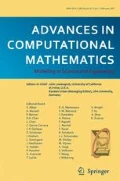Abstract
In this paper, we present a numerical method for solving reaction-diffusion equations on one dimensional branched structures. Through the use of a simple domain decomposition scheme, the many branches are decoupled so that the equations can be solved as a system of smaller problems that are tri-diagonal. This technique allows for locally adaptive time stepping, in which the time step used in each branch is determined by local activity. Though the method is presented in the specific context of electrical activity in neural systems, it is sufficiently general that it can be applied to other classes of reaction-diffusion problems and higher dimensions. Information in neurons, which can be effectively modeled as one-dimensional branched structures, is carried in the form of electrical impulses called action potentials. The model equations, based on the Hodgkin-Huxley cable equations, are a set of reaction equations coupled to a single diffusion process. Locally adaptive time stepping schemes are well suited to neural simulations due to the spatial localization of activity. The algorithm significantly reduces the computational cost compared to existing methods, especially for large scale simulations.
Similar content being viewed by others
References
Amitai, D., Averbuch, A., Israeli, M., Itzikowitz, S.: Implicit-explicit parallel asynchronous solver of parabolic PDEs. SIAM J. Sci. Comput. 19, 1366 (1998)
Belytschko, T., Gilbertsen, N.D.: Implementation of mixed time integration techniques on a vectorized computer with shared memory. Int. J. Numer. Methods Eng. 35(9), 1803–1828 (1992)
Belytschko, T., Yen, H., Mullen, R.: Mixed methods for time integration. Comput. Methods Appl. Mech. Eng. 17, 259–275 (1979)
Brown, P.N., Byrne, G.D., Hindmarsh, A.C.: VODE: a variable-coefficient ODE solver. SIAM J. Sci. Stat. Comput. 10(5), 1038–1051 (1989). doi:10.1137/0910062
Byrne, G.D., Hindmarsh, A.C.: A polyalgorithm for the numerical solution of ordinary differential equations. ACM Trans. Math. Softw. 1(1), 71–96 (1975). doi: 10.1145/355626.355636
Carnevale, N.T., Hines, M.L.: The neuron book. Cambridge University Press, New York (2006)
Cohen, S.D., Hindmarsh, A.C.: CVODE, a stiff/nonstiff ODE solver in C. Comput. Phys. 10(2), 138–143 (1996)
Cooley, J., Dodge, F.: Digital computer solutions for excitation and propagation of the nerve impulse. Biophys. J. 6(5), 583–599 (1966)
Courant, R., Friedrichs, K., Lewy, H.: Über die partiellen differenzengleichungen der mathematischen physik. Math. Ann. 100(1), 32–74 (1928)
Dawson, C., Du, Q., Dupont, T.: A finite difference domain decomposition algorithm for numerical solution of the heat equation. Math. Comput. 57(195), 63–71 (1991) [URL http://www.jstor.org/stable/2938663]
Gear, C.: Algorithm 407: DIFSUB for solution of ordinary differential equations [D2]. Commun. ACM 14(3), 190 (1971)
Gear, C.: The automatic integration of ordinary differential equations. Commun. ACM 14(3), 179 (1971)
Golding, N.L., Kath, W.L., Spruston, N.: Dichotomy of action-potential backpropagation in CA1 pyramidal neuron dendrites. J. Neurophys. 86(6), 2998–3010 (2001) [ http://jn.physiology.org/cgi/content/abstract/86/6/2998]
Hines, M.L.: Efficient computation of branched nerve equations. Int. J. Biomed. Comput. 15(1), 69–76 (1984)
Hines, M.L., Carnevale, N. T.: The neuron simulation environment. Neural Comput. 9(6), 1179–1209 (1997)
Hodgkin, A.L., Huxley, A.: A quantitative description of membrane current and its application to conduction and excitation in nerve. J. Physiol. 117, 500–544 (1952)
Kozloski, J., Wagner, J.: An ultrascalable solution to large-scale neural tissue simulation. Frontiers in Neuroinformatics 5, 1–21 (2011)
Kuznetsov, Y.A.: New algorithms for approximate realization of implicit difference schemes. Russ. J. Numer. Anal. Math. Model. 3(2), 99–114 (1988). doi: 10.1515/rnam.1988.3.2.99
Lee, J., Smaill, B.: Smith, N. (2006). http://linkinghub.elsevier.com/retrieve/pii/S0022519306000634
Markram, H.: The blue brain project. Nat. Rev. Neurosci. 7(2), 153–160 (2006). doi:10.1038/nrn1848. http://www.nature.com/nrn/journal/v7/n2/full/nrn1848.html
Mascagni, M.: The Backward Euler method for numerical solution of the Hodgkin–Huxley equations of nerve conduction. SIAM J. Numer. Anal. 27(4), 941–962 (1990). doi:10.1137/0727054. http://link.aip.org/link/?SNA/ 27/941/1
Mascagni, M.: A parallelizing algorithm for computing solutions to arbitrarily branched cable neuron models. J. Neurosci. Methods 36(1), 105–114 (1991)
Migliore, M., Cannia, C., Lytton, W.W., Markram, H., Hines, M.L.: Parallel network simulations with neuron. J. Comput. Neurosci. 21(2), 119–129 (2006). doi:10.1007/s10827-006-7949-5 [ http://www.springerlink.com/ content/r41x6t86x6033533/]
Nicolson, P., Crank, J.: A practical method for numerical evaluation of solutions of partial differential equations of the heat-conduction type. Proc. Camb. Philos. Soc. 43(1), 50–67 (1947)
Rempe, M.J., Chopp, D.L.: A predictor-corrector algorithm for reaction-diffusion equations associated with neural activity on branched structures. SIAM J. Sci. Comput. 28(6), 2139–2161 (2006). doi:10.1137/050643210. http://link.aip.org/link/?SCE/28/2139/1
Rempe, M.J., Spruston, N., Kath, W.L., Chopp, D. L.: Compartmental neural simulations with spatial adaptivity. J. Comput. Neurosci. 25(3), 465–480 (2008). doi:10.1007/s10827-008-0089-3
Shampine, L.F.: Numerical solution of ordinary differential equations. NY, New York (1997)
Shi, H.S., Liao, H.L.: Unconditional stability of corrected explicit-implicit domain decomposition algorithms for parallel approximation of heat equations. SIAM J. Numer. Anal. 44, 1584 (2006)
Smolinski, P., Wu, Y.: An implicit multi-time step integration method for structural dynamics problems. Comput. Mech. 22(4), 337–343 (1998)
Tan, Z., Zhang, Z., Huang, Y., Tang, T.: Moving mesh methods with locally varying time steps. J. Comput. Phys. 200(1), 347–367 (2004)
Xiao, S., Belytschko, T.: A bridging domain method for coupling continua with molecular dynamics. Comput. Methods Appl. Mech. Eng. 193(17-20), 1645–1669 (2004)
Zhuang, Y., Sun, X.H.: Stable, globally non-iterative, non-overlapping domain decomposition parallel solvers for parabolic problems. Proceedings of the 2001 ACM/IEEE conference on Supercomputing (CDROM), 19 (2001)
Zhuang, Y., Sun, X.H.: Stabilized explicit-implicit domain decomposition methods for the numerical solution of parabolic equations. SIAM J. Sci. Comput. 24(1), 335–358 (2002). doi:10.1137/S1064827501384755. URL http://link.aip.org/link/?SCE/24/335/1
Author information
Authors and Affiliations
Corresponding author
Additional information
Communicated by: Gunnar J. Martinsson
Rights and permissions
About this article
Cite this article
Kublik, R.A., Chopp, D.L. A locally adaptive time stepping algorithm for the solution to reaction diffusion equations on branched structures. Adv Comput Math 42, 621–649 (2016). https://doi.org/10.1007/s10444-015-9437-9
Received:
Accepted:
Published:
Issue Date:
DOI: https://doi.org/10.1007/s10444-015-9437-9




